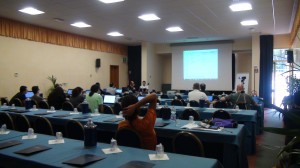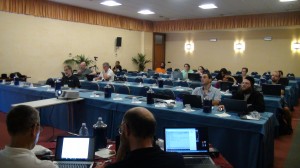 Morten Kromberg went right to it with his well-prepared workshop on the prototype features that were introduced in version 14.0 of Dyalog APL. The features are still partly modelled in APL to allow the first wave of users to pass judgement on the design. Throughout the workshop, we were asked for feedback, to ensure that the new primitives will be as well implemented as possible.
Morten Kromberg went right to it with his well-prepared workshop on the prototype features that were introduced in version 14.0 of Dyalog APL. The features are still partly modelled in APL to allow the first wave of users to pass judgement on the design. Throughout the workshop, we were asked for feedback, to ensure that the new primitives will be as well implemented as possible.
Everyone is encouraged to apply the new tools in practice so they can be adjusted and possibly get expanded functionality based on feedback from actual use-cases.
There is no denying the the obvious performance gains that Morten demonstrated: He was able to let the computer waste 9 idle seconds in only slightly more than 3 seconds!
Joking aside, one practical example that showed how useful parallel processing can be, was collating character counts from online news sites. Because of latency in loading these pages over the internet, starting many parallel threads that each requested a page greatly reduced the wait time.  One workshop participant volunteered a piece of code that needed to be parallelized got up and pair programmed this with immediately achieving significant performance gains.
One workshop participant volunteered a piece of code that needed to be parallelized got up and pair programmed this with immediately achieving significant performance gains.
The idea of Futures is allowing the continuation of other work before an asynchronously launched calculation is finished. All selection and structural functions can be used on an array containing futures without blocking to wait for the result, as long as no actual data values are required. Meanwhile, other processes (or computers!) could be finishing the evaluation in the background.
It was captivating to observe output being printed and check the status while the calculation work progressed, or accessing parts of an array while other parts still reported as in progress. Morten even had a graphical representation of how load is distributed across processor cores.
Maybe the most exciting thing about all this is that we will soon welcome several new APL squiggles; Isolate (¤) and Parallel (∥). And at the end of the day, Morten even pulled a pet (pun intended) card out of his sleeve: A Schrödinger’s cat operator! The symbol is of course a question mark in a box (⍰), signifying how the evaluation of the cat’s life (or in our case – the result) does not even begin until actually queried. This is a novel way to specify specific lazy evaluation.
All in all, an exciting look at what possibilities for parallelism the future will bring.


 Follow
Follow